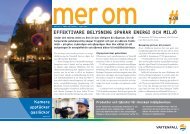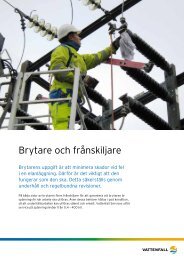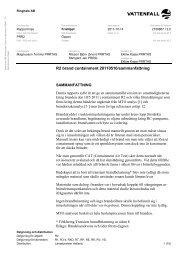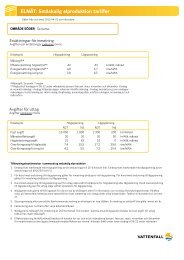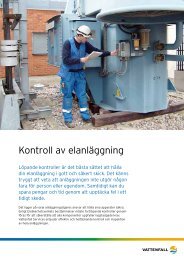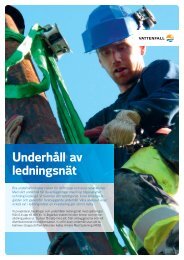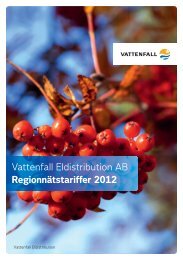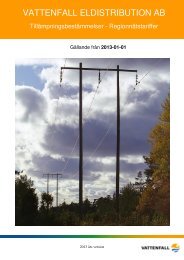This environmental impact assessment for Kriegers flak ... - Vattenfall
This environmental impact assessment for Kriegers flak ... - Vattenfall
This environmental impact assessment for Kriegers flak ... - Vattenfall
Create successful ePaper yourself
Turn your PDF publications into a flip-book with our unique Google optimized e-Paper software.
126 CONSEQUENSES OF THE WIND FARM<br />
seabed conditions (Wahlberg and Westerberg, 2004).<br />
Theoretically, the noise from wind turbines could<br />
frighten Þ sh, but only within a distance of maximum<br />
4 metres and only at high wind speeds, 13 m/s (Wahlberg<br />
and Westerberg, 2004).<br />
Studies show that Þ sh learn to associate certain<br />
noise with a certain occurrence. <strong>This</strong> could result in<br />
that Þ sh associate noise from wind turbines with a nondangerous<br />
structure that does not frighten them.<br />
Noise measurements from the wind farm at Utgrunden<br />
show that the noise emitted by the turbines<br />
not even frightens the Þ sh away at a distance of 1 metre<br />
from the turbines. <strong>This</strong> could indicate that Þ sh associate<br />
the noise from wind turbines with something that is<br />
not dangerous.<br />
It may further be assumed that the continuity of<br />
noise is a determining factor <strong>for</strong> the reactions of Þ sh.<br />
Westerbergs investigations of Þ sh behaviour near<br />
bridges with car and train trafÞ c showed that Þ sh did<br />
not to any great extent react to the more or less continuous<br />
trafÞ c, but that shoal of Þ sh could make vertical<br />
movement changes at sudden noise emissions, such<br />
as when a train passed the bridge. <strong>This</strong> would indicate<br />
that the continuous noise from wind turbines will not<br />
have a signiÞ cant <strong>impact</strong> on Þ sh. However, no certain<br />
conclusions can be drawn as the study was limited in<br />
scope.<br />
For many Þ sh, noise signals are important in order<br />
to localise each other during spawning and signal readiness<br />
<strong>for</strong> mating. Noise and vibrations could there<strong>for</strong>e<br />
inß uence the suitability of an area <strong>for</strong> spawning. Studies<br />
show that noise from wind turbines may inß uence<br />
signalling of Þ sh at a distance of several kilometres<br />
but the degree of importance of such inß uence is not<br />
known (Wahlberg and Westerberg, 2004).<br />
Studies have shown that if Þ sh continuously are subjected<br />
to high noise levels, damage to the inner ear can<br />
follow (Hastings et al., 1996, McCauley et al., 2003).<br />
There is, however, nothing that indicates that noise<br />
from wind turbines may, temporarily or permanently,<br />
damage the hearing of Þ sh (Wahlberg and Westerberg,<br />
2003).<br />
The studies that have been made on the <strong>impact</strong> of<br />
noise on Þ sh have generally been conducted on single<br />
turbines and smaller structures. The results cannot,<br />
there<strong>for</strong>e, easily be transferred to large wind farms. It<br />
should also be noted that the knowledge of the <strong>impact</strong><br />
on roe and juvenile Þ sh is very small. Following a<br />
review of the studies, Wahlberg and Westerberg (2004)<br />
conclude that juvenile Þ sh are at least as sensitive as<br />
grown species while roe is considered less sensitive.<br />
A careful judgement would however be that noise<br />
from wind turbines does not have any important negative<br />
<strong>impact</strong> on Þ sh. The fact that large numbers of Þ sh<br />
have been registered at Horns Rev (Hvidt et al., 2004)<br />
supports this theory.<br />
The effect of noise and vibrations on Þ sh will be<br />
studied closely during a control programme following<br />
the construction of the wind farm. The control programme<br />
is described in Attachment 19.10.1.<br />
The dismantling phase<br />
Noise during the dismantling phase may temporarily<br />
frighten the Þ sh away. Noise that causes damage<br />
to the hearing of Þ sh is not very likely, but cannot be<br />
excluded.<br />
b) Light, shadows and refl exes<br />
During the operational phase, light is generated from<br />
the ß oodlights on the turbines. Light is known to attract<br />
Þ sh but apart from a possible collision risk, Þ xed<br />
light points are not considered to cause any negative<br />
<strong>impact</strong>.<br />
During the operational phase, the towers and the<br />
blades cause shadows that could have an <strong>impact</strong>.<br />
During the construction and dismantling phases, the<br />
shadows are temporary and during these periods, the<br />
<strong>impact</strong> is limited.<br />
Fixed shadows, such as behind the towers, attracts<br />
Þ sh and is not considered to have a negative <strong>impact</strong>.<br />
Fast movements that are mirrored on the water surface,<br />
could on the other hand cause unrest. The blades,<br />
sweeping over a large area, cause a ß uctuating shadow<br />
on the water surface. Many organisms react by escaping<br />
or by carefulness in similar situations. Among<br />
anglers and scientists, it is considered common knowledge<br />
that Þ sh react by escaping or seeking protection<br />
when a shadow passes over them. The reason is probably<br />
a protective measure so as not to become feed <strong>for</strong><br />
praying birds. Whether the Þ sh can get used to these<br />
intermittent shadows has not yet been studied, but it is<br />
regarded as likely that Þ sh get accustomed to it.<br />
It should be noted that the light penetration in the<br />
Baltic Sea stops at a depth of 20 – 25 metres, and it is





